 Database
Database
 Mysql Tutorial
Mysql Tutorial
 Detailed explanation of the master-slave replication process in MySQL_Detailed explanation of Mysql examples
Detailed explanation of the master-slave replication process in MySQL_Detailed explanation of Mysql examples
Detailed explanation of the master-slave replication process in MySQL_Detailed explanation of Mysql examples
This article mainly introduces the implementation process of MySQL master-slave replication in detail. It has certain reference value. Interested friends can refer to it. I hope it can help everyone.
1. What is master-slave replication
Transmit the DDL and DML operations in the master database to the slave database through binary logs (BINLOG), and then transfer these logs Re-execute (redo); thus making the data in the slave database consistent with the master database.
2. The role of master-slave replication
1. If there is a problem with the master database, you can switch to the slave database.
2. Read and write separation can be performed at the database level.
3. Daily backup can be performed on the slave database.
3. Replication process
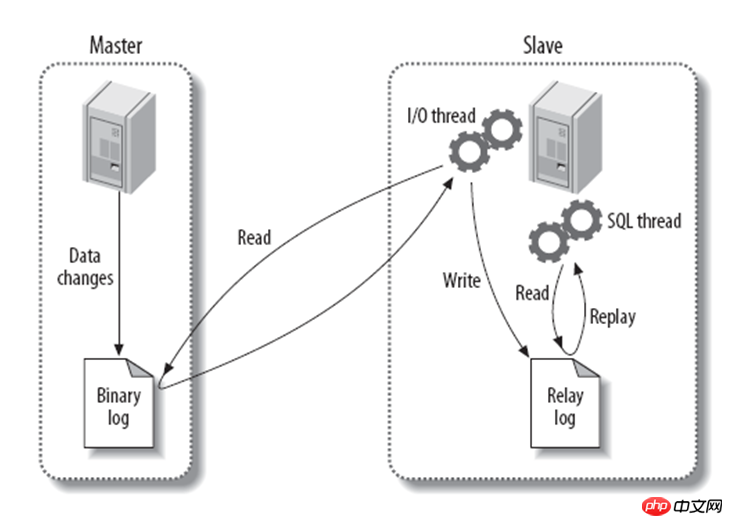
Binary log: Binary log of the master database
Relay log: Relay log of the slave server
Step one: master writes the operation record serially to the binlog file before each transaction update data is completed.
Second step: salve opens an I/O Thread. This thread opens a normal connection on the master and its main job is the binlog dump process. If the reading progress has caught up with the master, it enters sleep state and waits for the master to generate new events. The ultimate purpose of the I/O thread is to write these events to the relay log.
Step 3:SQL Thread will read the relay log and execute the SQL events in the log sequentially to be consistent with the data in the main database .
4. Specific operations of master-slave replication
I installed two msyql instances in different paths on the same windows. It is recommended that the installed versions of mysql between the master and slave here are consistent, although my own is inconsistent.

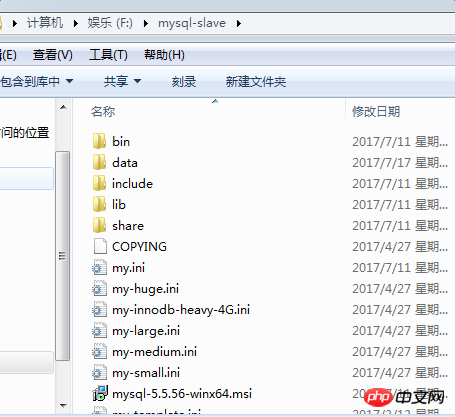
#1. Modify the configuration files my.ini of the master and slave databases respectively
master
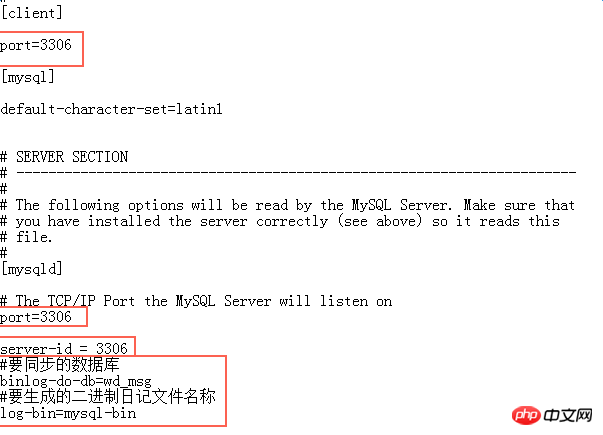
3306 is the default port number of mysql, which does not need to be modified in the master instance; server-id is used to specify a unique ID, and different mysql instances do not need to be repeated; binlog-do-db needs to be copied if specified database; log-bin is used to open binary log files.
salve
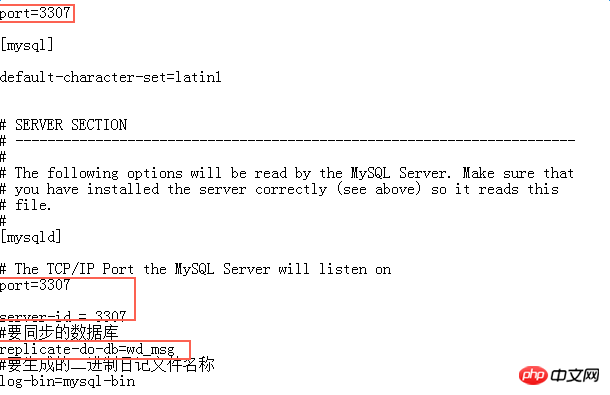
Since the master-slave database will be run on the same computer later, the port needs to be set to different Same, here is 3307
replicate-do-db: the name of the database that needs to be synchronized, consistent with the configuration on the master.
2. Create an account specifically for replication on the master: weidai/123456

This new account can be found in the table mysql.user Query:
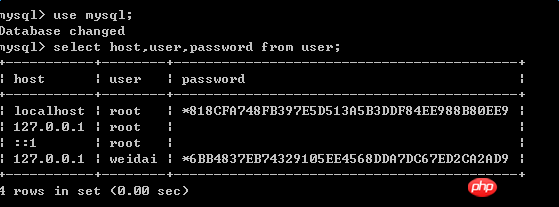
When I first operated, I completed the creation of this account here, but when I actually copied it, I found that there was no copy. Successfully, when troubleshooting the error, it was found that there was no problem with the binlong generated by the master, and then checked the status of the slave:

There is such an error line at the end:

Using the Weidai account cannot connect to the master, so the master's binlog should not be obtained, resulting in the relay log not being generated.
I repeatedly checked the account and password and found no problems. Then I searched for relevant information and found out that it was because there was a missing step when the master created a new user:
Set up a new user or change it After entering the password, you need to use flush privileges to refresh MySQL's system permissions related tables, otherwise access will be denied. This is why the previous error occurred. Another way is to restart the mysql server to make the new settings take effect.

3. Obtain the position of the data in the master database at this moment. It is mainly used to copy the starting position of the data after starting from the data. However, before obtaining this status value, the master The database can no longer have data modification operations, so it is necessary to set the read lock to be valid


4. The main library performs data backup. There are many methods of backup. I will not introduce them here. You can refer to my previous article. After the backup is completed, the read lock can be released and the main library can perform write operations.

5. Start the slave database and restore the data just backed up. At this time, the data of the master and slave databases at the backup time point are consistent.
6. Configuration related to replication behavior on the slave database
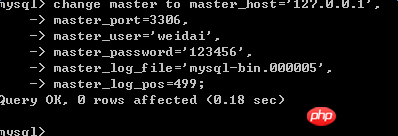
7. At this time, the configuration is completed, but the slave database cannot yet be synchronized and needs to be started. slave thread

#8. Create a table and add new data in the master, and observe in the slave:
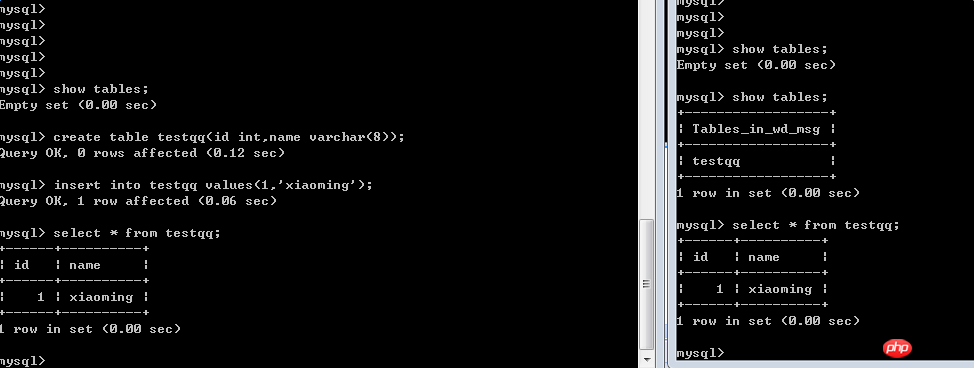
Yes It can be seen that the operations I perform in the master can be reflected in the slave. At this time, the slave is like a mirror of the master.
5. Interpretation of master-slave synchronization status
Use the command on the slave to view:
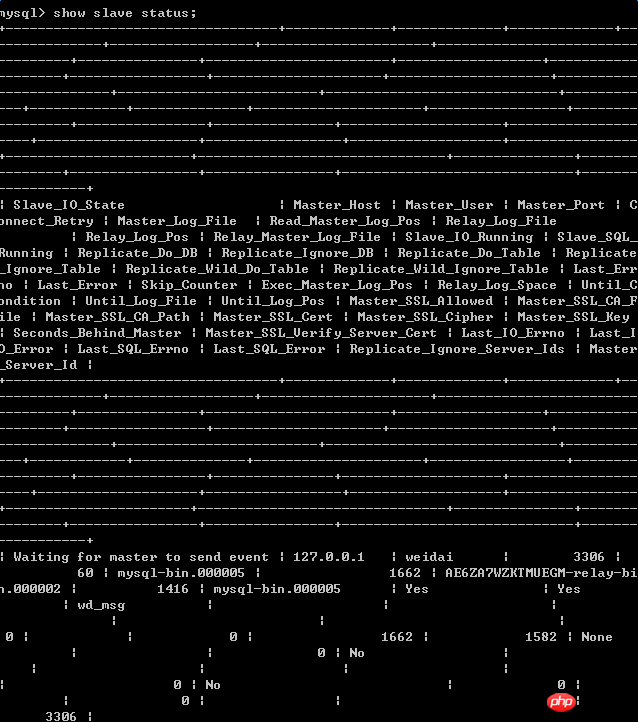
Due to typesetting It’s too ugly, so I organized it as follows:
Slave_IO_STATE:Waiting for master to send event
Master_host:127.0.0.1
Master_user:weidai
Master_port: 3306
connnect_retry:60
Master_log_file:mysql-bin.000005
Read_Master_log_pos:1662
Relay_log_file:AE6Z*****-relay-bin .000002
Relay_log_pos:1415
Slave_IO_Running:yes
Slave_SQL_Running:yes
------------- -----------------------------------------------Gorgeous dividing line--- ----------------------------------------
Slave_IO_Running:yes
Slave_SQL_Running:yes
As mentioned earlier, these two threads are two very important threads involved in the replication process on the slave. YES means normal, NO means abnormal.
The Slave_IO thread mainly copies the binlong log content on the master to the slave's relay log (Relay_log). Generally, the probability of problems is small. Most problems are caused by permissions or network issues. Unable to connect to master. Just like the error mentioned earlier.
The Slave_SQL thread is responsible for executing the SQL in the relay log, and the probability of errors is relatively high. If someone manually inserts some records into the slave database, a primary key conflict will occur during master-slave synchronization.
Slave_IO_STATE:Waiting for master to send event
This status indicates that the relay log synchronization is completed and waiting for new events to be generated by the master.
Related recommendations:
Detailed explanation on setting up a master-slave instance for MySQL5.7.18 master-slave replication
Mycat read-write separation in MySQL Example implemented based on master-slave replication
Detailed example of how MySQL implements the master-slave replication process (picture)
The above is the detailed content of Detailed explanation of the master-slave replication process in MySQL_Detailed explanation of Mysql examples. For more information, please follow other related articles on the PHP Chinese website!

Hot AI Tools

Undresser.AI Undress
AI-powered app for creating realistic nude photos

AI Clothes Remover
Online AI tool for removing clothes from photos.

Undress AI Tool
Undress images for free

Clothoff.io
AI clothes remover

Video Face Swap
Swap faces in any video effortlessly with our completely free AI face swap tool!

Hot Article

Hot Tools

Notepad++7.3.1
Easy-to-use and free code editor

SublimeText3 Chinese version
Chinese version, very easy to use

Zend Studio 13.0.1
Powerful PHP integrated development environment

Dreamweaver CS6
Visual web development tools

SublimeText3 Mac version
God-level code editing software (SublimeText3)

Hot Topics
 How to open phpmyadmin
Apr 10, 2025 pm 10:51 PM
How to open phpmyadmin
Apr 10, 2025 pm 10:51 PM
You can open phpMyAdmin through the following steps: 1. Log in to the website control panel; 2. Find and click the phpMyAdmin icon; 3. Enter MySQL credentials; 4. Click "Login".
 MySQL: An Introduction to the World's Most Popular Database
Apr 12, 2025 am 12:18 AM
MySQL: An Introduction to the World's Most Popular Database
Apr 12, 2025 am 12:18 AM
MySQL is an open source relational database management system, mainly used to store and retrieve data quickly and reliably. Its working principle includes client requests, query resolution, execution of queries and return results. Examples of usage include creating tables, inserting and querying data, and advanced features such as JOIN operations. Common errors involve SQL syntax, data types, and permissions, and optimization suggestions include the use of indexes, optimized queries, and partitioning of tables.
 MySQL's Place: Databases and Programming
Apr 13, 2025 am 12:18 AM
MySQL's Place: Databases and Programming
Apr 13, 2025 am 12:18 AM
MySQL's position in databases and programming is very important. It is an open source relational database management system that is widely used in various application scenarios. 1) MySQL provides efficient data storage, organization and retrieval functions, supporting Web, mobile and enterprise-level systems. 2) It uses a client-server architecture, supports multiple storage engines and index optimization. 3) Basic usages include creating tables and inserting data, and advanced usages involve multi-table JOINs and complex queries. 4) Frequently asked questions such as SQL syntax errors and performance issues can be debugged through the EXPLAIN command and slow query log. 5) Performance optimization methods include rational use of indexes, optimized query and use of caches. Best practices include using transactions and PreparedStatemen
 Why Use MySQL? Benefits and Advantages
Apr 12, 2025 am 12:17 AM
Why Use MySQL? Benefits and Advantages
Apr 12, 2025 am 12:17 AM
MySQL is chosen for its performance, reliability, ease of use, and community support. 1.MySQL provides efficient data storage and retrieval functions, supporting multiple data types and advanced query operations. 2. Adopt client-server architecture and multiple storage engines to support transaction and query optimization. 3. Easy to use, supports a variety of operating systems and programming languages. 4. Have strong community support and provide rich resources and solutions.
 How to connect to the database of apache
Apr 13, 2025 pm 01:03 PM
How to connect to the database of apache
Apr 13, 2025 pm 01:03 PM
Apache connects to a database requires the following steps: Install the database driver. Configure the web.xml file to create a connection pool. Create a JDBC data source and specify the connection settings. Use the JDBC API to access the database from Java code, including getting connections, creating statements, binding parameters, executing queries or updates, and processing results.
 How to start mysql by docker
Apr 15, 2025 pm 12:09 PM
How to start mysql by docker
Apr 15, 2025 pm 12:09 PM
The process of starting MySQL in Docker consists of the following steps: Pull the MySQL image to create and start the container, set the root user password, and map the port verification connection Create the database and the user grants all permissions to the database
 Centos install mysql
Apr 14, 2025 pm 08:09 PM
Centos install mysql
Apr 14, 2025 pm 08:09 PM
Installing MySQL on CentOS involves the following steps: Adding the appropriate MySQL yum source. Execute the yum install mysql-server command to install the MySQL server. Use the mysql_secure_installation command to make security settings, such as setting the root user password. Customize the MySQL configuration file as needed. Tune MySQL parameters and optimize databases for performance.
 How to install mysql in centos7
Apr 14, 2025 pm 08:30 PM
How to install mysql in centos7
Apr 14, 2025 pm 08:30 PM
The key to installing MySQL elegantly is to add the official MySQL repository. The specific steps are as follows: Download the MySQL official GPG key to prevent phishing attacks. Add MySQL repository file: rpm -Uvh https://dev.mysql.com/get/mysql80-community-release-el7-3.noarch.rpm Update yum repository cache: yum update installation MySQL: yum install mysql-server startup MySQL service: systemctl start mysqld set up booting





